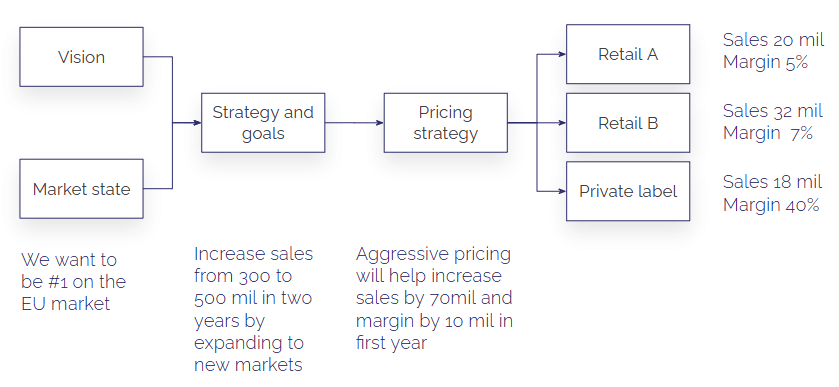How to define your pricing strategy
Pricing across multiple markets
How do you create a pricing strategy, and more importantly, what should you base it on? First and foremost, you need a well-defined overall business strategy and goals. If these are missing, pause your work on Pricing Academy and focus on developing your company’s strategy first. Without a solid foundation, you won’t be able to build an effective pricing approach.
As you shape your overall business strategy, don’t forget a few key elements that will later help you define your pricing strategy more effectively.
If your company strategy is already in place, take a moment to check whether these key points are clearly defined.
Regardless of your chosen pricing strategy, it’s essential to continuously monitor market conditions. The approach to pricing will differ depending on whether you're selling high-competition products like toner cartridges or smartphones, versus niche items like handcrafted toothbrushes made from Nigerian sandalwood.
Understanding your competitors is key—if you have access to competitive data, use it. Otherwise, consider automated tools for competitor price monitoring. If such tools aren’t an option, dedicate a few hours each week to manually checking the prices of your top products. However, keep in mind that product rankings change over time, and manual checks become increasingly inefficient.
Analyzing your marketing channels can help you assess whether your strategy is on the right track. In general:
From an economic perspective, your goal is to understand the price elasticity of demand for your products.
For example:
If your business strategy and goals are clearly defined—following the SMART framework (Specific, Measurable, Achievable, Relevant, Time-bound)—they serve as a strong foundation for your pricing strategy. You should also understand how pricing connects to the strategies of other teams: What are marketing, logistics, finance, and product teams planning for the next period? The better you understand company-wide plans, the more effectively you can align your pricing strategy with them.
Once your business strategy is in place, you can define pricing strategies and objectives for individual teams. Who is responsible for pricing? Pricing affects multiple departments, so collaboration is essential—but ultimately, one team should own it.
From a marketing mix (4P) perspective, pricing (Price) typically falls under marketing, alongside promotion, place, and product. However, in retail and online businesses, pricing is often managed by the product, purchasing, or sales teams.
Among our clients, we most often see pricing responsibility assigned to the product team, while marketing focuses primarily on product promotion. Both approaches can work—it depends on the expertise and seniority of the teams, their cross-functional capabilities, and the company’s pricing objectives.
Once your overall business strategy shapes your pricing strategy, you can further break it down into specific objectives for different segments—whether by country (for businesses operating in multiple markets) or by product category. Within each segment, the focus shifts to selecting the right pricing tactics to achieve these objectives.
Imagine a company aiming to double its revenue from € 300 mil to € 500 mil within two years (goal). The company sells standard retail products, which many competitors also offer, but it also has a private-label line with significantly higher margins. Since the domestic market is already saturated, the company chooses expansion into three new international markets as its growth strategy.
For each new market, the company conducts a macro-economic analysis, competitive research, and consumer behavior study to set its annual revenue targets. It then aligns its pricing strategy with broader company initiatives:
As a result, pricing gets a concrete target:
With the pricing strategy in place, it is now applied to different product categories:
These tactics will be evaluated after the first few months, allowing for adjustments based on performance data.

A simplified example illustrates how overall strategy and goals gradually break down into specific tasks, eventually leading to the selection of tactics for individual product segments. What once seemed like a complex black-box pricing process becomes a clear, structured approach—easy to manage and measure.
But what if we find that some parts of the strategy are no longer working or seem unlikely to achieve their intended goals? In that case, it’s not the entire strategy that needs to change, but rather the tactics. Pricing remains flexible, allowing for adjustments and optimizations while staying aligned with the broader business objectives.
What is your business strategy? To what extent did you achieve your previous goals, and where do you stand now? Why did you exceed or fall short of them? How will this impact your current strategy?
What is the market situation? Who are your competitors, and why do they compete with you?
Where do your customers come from? Can you break it down by percentage? Does this vary by segment or category? How significantly, and why?
How do you currently structure your product portfolio? Do you categorize it by manufacturer, brand, category, or something else? What is the reasoning behind this approach?